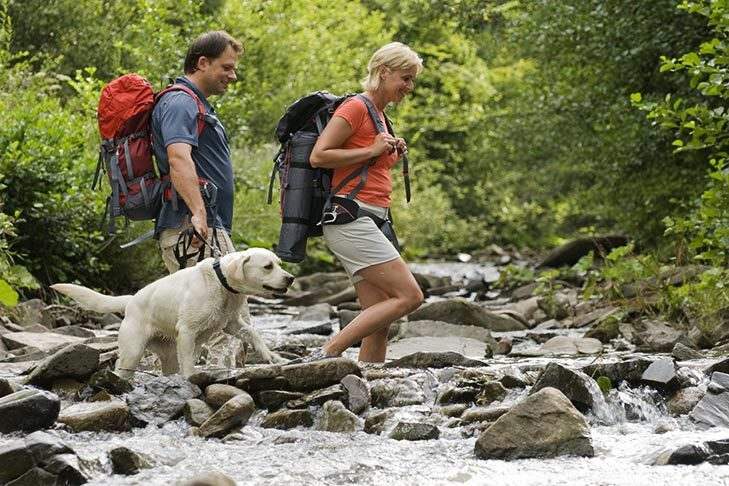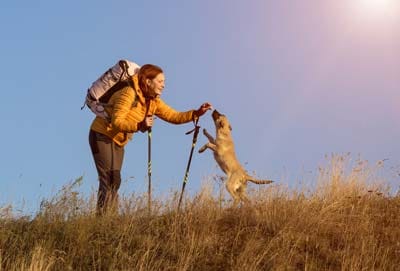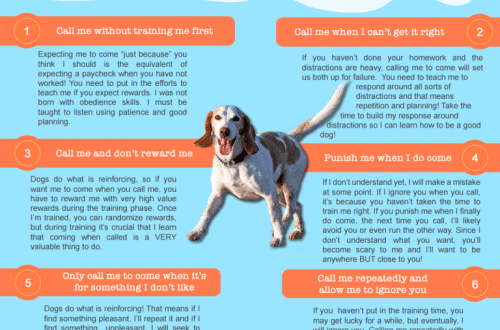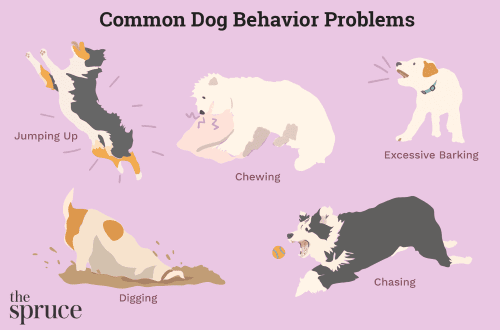
On a hike with your dog!

Finally warm days have come, vacation is just around the corner. Not all owners are ready to part with their dogs for a vacation, or want to go with a friend. Increasingly these days the dog is not a burden. They take it with them on swimming, in the mountains, on the beach, on a hike. It brings people and their pets closer together, and makes it possible to spend time outdoors together. But for any trip you need to prepare in advance, not only to pack your backpack, but also to prepare the dog. Let’s talk today about what a pet needs on a hike.
Contents
What dogs can be taken on a hike
An important question is what kind of dogs you can take with you on a hike. There are many nuances that you need to pay attention to in order to ensure comfortable movement for yourself and your pet. Dogs of miniature breeds such as Chihuahua, Russian Toy, Pomeranian are more difficult to travel long distances and may need to be carried by hand or in a carrier. At the same time, small dogs, especially terriers – Jack Russells, standard Yorkshire terriers, Norwich terriers, fox terriers and others, as well as miniature pinschers and miniature schnauzers – are active and strong, they can participate well in hiking. Large and giant dogs – mastiffs, great danes, due to their large mass and load on the musculoskeletal system, also experience inconvenience during prolonged exercise. Large, lightly built dogs such as Rhodesian Ridgebacks and Giant Schnauzers tire less and are able to walk longer distances without fatigue. Difficulties and fatigue can be encountered by short-legged dogs: bassets, dachshunds, corgis, scotch terriers. These dogs will be more comfortable on short trips or need rest breaks. It can be difficult for brachycephals – bulldogs, pugs, griffons, due to the structure of the skull, they may experience difficulty breathing, this can lead to hypoxia and overheating. However, they can be taken on simple and not long hikes. The easiest way to adapt to hiking conditions are active dogs of medium and large sizes – huskies, huskies, shepherds, mountain dogs, Pyrenean mountain dogs, retrievers, setters, weimaraners, beagles, pit bull terriers, Staffordshire terriers, Irish terriers, border collies and others. Of course, you should take into account the condition of the dog, because any overweight dog will have a hard time walking, and just proceed from the individual characteristics of a particular dog. It is also important to consider obedience. The connection between the pet and the owner must be strong, mutual understanding is needed in order to avoid situations with the dog getting into trouble or so that it does not run away and do not have to look for it. A well-trained and socialized tailed companion will make your travel life easier. Knowledge of basic commands: “come”, “stop”, “no” are necessary in trekking conditions. This is a guarantee of the safety of your friend and others. In addition to the fact that the pet must tolerate long walks well, it must be remembered that you need to get to the mountains or the forest on something, often this is a vehicle, so the dog must be ready for this as well. If the place of the hike is far from home, and you travel with your dog by car, train, or plane, you can find out how to prepare here. Of course, you should not take with you a pet that is too young, old or has acute / chronic diseases. Since the load on the body is increased and you may encounter an exacerbation, deterioration of the condition. It is recommended to leave such dogs in zoo hotels and overexposures, if necessary, in a veterinary clinic, where they can immediately provide medical assistance and the animal is under round-the-clock supervision of specialists. In order not to worry, you can ask the staff to send you a photo of your pet upon request.
How to prepare for a hike
You need to worry about preparing your pet for a hike in advance.
- Study the features of the area. What dangers can await there, what dangerous insects and wild animals live.
- Look in advance at the veterinary passport. Make sure that the dog has been vaccinated this year, if not, then it should be treated for worms and vaccinated after 10-14 days.
- If the dog does not tolerate the road in vehicles, then it is worth starting a course of sedatives in advance.
- Do not forget to treat the dog from fleas, ticks, midges, horseflies.
What to take with you on a hike
What can your pet need on a hike? In order not to forget anything, start making a list of what you need in advance and gradually supplement it. Some familiar things in everyday life can just fly out of your head.
- Car hammock, seat belt – when moving in a car.
- Travel foam or blanket, it will be more comfortable for the dog to sleep in a tent. If hiking in winter, you can even take a separate sleeping bag, many dogs sleep comfortably in them. It is not recommended to tie them to a tree at night or leave them unattended at night.
- Be sure to bring a leash, collar or harness with you. The leash must be canvas or nylon, not leather, and must be at least 2 meters long. The roll doesn’t fit. The harness or collar should be comfortable, ideally already worn, and should not rub.
- Muzzle. Required for public transport. The design should allow you to breathe freely with your mouth open to avoid overheating.
- Address book. Be sure to attach your data to the collar so that if the dog runs away and gets lost, it could be returned to you. Do not be arrogant, the dog may simply be afraid of something unexpected for her, although she is very well-mannered.
- If a dog of a medium or large breed can be purchased for her special bag, which she herself will carry, you can put and attach the necessary items there. If the dog is small or you simply do not want to load it, then think about how you will carry, in addition to your own, her things.
- It is recommended to use reflective ammunition and luminous key chains or collars. You can also put on a bright vest with reflective stripes on the dog so that it can be clearly seen both at night and during the day, especially if the pet has a color that blends with nature. This will help both you and other people, for example, not to be afraid, mistaking for a wild animal, and not to lose sight of the dog day or night.
- Take with you a travel drinking bottle, a bowl – a silicone folding bowl, or a soft waterproof fabric. If there are no reservoirs and streams along the route, you need to take water with you per pet.
- Get your dog a raincoat and safety boots. If hiking in winter, you can wear warm overalls and a vest, in the mountains it can be quite cold and windy at night.
- Care products – wipes for paws to wipe before entering the tent, for ears and eyes – for cleaning if necessary. Dog cleaning bags can also come in handy, where needed.
- Life jacket if traveling on water.
- A ball or any other favorite toy for parking games. If the animal is not tired enough during the day, active games before going to bed will bring pleasure to all members of the group without exception.
First aid kit for dogs
First of all, the first aid kit should include drugs that the dog takes on an ongoing basis (for chronic diseases) or there is a possibility of exacerbations. The list of required includes:
- Antiseptics. Chlorhexidine, peroxide, Ranosan powder or ointment, hemostatic powder or hemostatic sponge.
- Bandages, gauze pads and cotton pads, self-locking bandage, plaster.
- Thermometer.
- Tick twister.
- Antipyretic and analgesic. Only special preparations for dogs: Loxicom, Previcox, Rimadil.
- Antihistamines – Suprastin, Tavegil.
- Scissors and tweezers.
- Syringes.
- Physiological solution Sodium chloride 0,9%.
- Smecta or Enterosgel.
Dog food
If your dog is on an industrial diet, then everything is simple. Carry a supply of dry food, preferably labeled for active dogs, or canned wet food. These products do not require special temperature storage conditions. If the pet is on home food, then it is more difficult. Cooking, and even more so keeping meat products fresh in field conditions, is problematic. In this case, the same canned food for dogs can come to the rescue. They are more suitable in composition and structure to homemade food. Or at home, you can dry meat, vegetables for the dog and cook on a fire.
Dangers on the hike
Pay attention to the fact that the dog can also be in danger: fast rivers, rocks, stone screes. Be prepared for the fact that in some places you will need to carry the dog or try to avoid dangerous routes. Watch your dog, belay on dangerous sections of the path. Also dangerous are ticks, insects, snakes, and other wild animals.
- If you notice a tick on the dog, then you need to carefully remove it with a twister. Treat the bite site with an antiseptic. Monitor the condition of the dog. In case of lethargy, elevated temperature, refusal to feed, urination with blood, it is necessary to complete the trip and urgently contact the clinic.
- A dog can be bitten by a snake, either venomous or non-venomous. Perhaps the dog accidentally steps on the snake’s tail or starts chasing it out of hunting interest. Dogs usually get bitten on the nose, lips, tongue, or front paws. The muzzle swells, behavior changes, anxiety, movement disorders, vomiting appear when bitten by a poisonous snake. If the snake was not poisonous, for example, or a snake, in the south – an extremely aggressive Caspian snake, treat the wounds with peroxide. If the dog was bitten by a poisonous snake – in the middle lane it is most often an ordinary viper, in the south of Russia a Caucasian viper, viper and muzzle can be found – wash the bite site, for example, with hydrogen peroxide, but in no case with alcohol or ether, which contribute to the absorption of poison . Limit the movement of the dog, apply ice to the bite site, give the dog an antihistamine – Suprastin or Tavegil, and drink plenty of water. Tourniquets are highly not recommended – their imposition causes a violation of blood flow, but almost always sharply worsens the condition of the victim, and can also lead to necrosis. A visit to the veterinarian is required.
- If the dog has been stung by a bee or other stinging insect, do not panic. Inspect the wound, remove the poison sac, if any (bees and bumblebees leave a jagged sting with a poison sac in the skin, wasps and hornets do not, they have a smooth sting and they are able to sting several times). Treat the bite site with peroxide, give the dog an antihistamine. Most often, the dog receives bites in the muzzle, nose, mouth and paws. The affected area swells, the dog may go into shock: difficulty breathing, blue tongue, foam from the mouth, vomiting, loss of consciousness – depends on the tolerance of the poison. If you notice symptoms that indicate shock, you need to contact your veterinarian.
- Wild animals. A dog can run after any wild animal, chasing out of the excitement of hunting – regardless of breed. Animal – can both run away and fight back if it is large and self-confident – for example, a bear or a wild boar. Even a deer or elk can kick a dog with a sharp hoof if it gets too close. With a noticed interest in a wild animal, the dog must be recalled and taken on a leash. Do not let them play with hedgehogs – they usually have a lot of parasites due to needles, and they can also be carriers of rabies. When chasing birds, foxes, deer or others, a dog may be injured while running after them, or fall off rocks without looking where it is running.
- On dangerous sections of the path – through the ford during the current, the dog can be kept on a leash and supported, or if the dog is medium-sized – carried in your arms if it is blown away by the current. on the rocks – it will be safer to climb itself. Dogs are instinctively afraid of heights and walk carefully. When a person or dog falls while tied up with a leash, there is a very high chance of falling and more seriously injuring both. Going down is scarier and more difficult for them. It may take your participation to help them get off. The dog, seeing that people descend where it is afraid, often panics, whines or howls – it is afraid that you will leave it. The dog can behave unpredictably – jump down or start looking for other ways and get stuck even worse. Therefore, it is not necessary to leave the dog last. Let one person stay with her and guide her, and the other person receive her below. Screes: dangerous for both the dog and the owner, since the dog from above can lower stones on people. In such places, everyone should go together. If the dog does not listen to the “near” command, you need to take it on a leash. If the hike is difficult, with steep sections, it is necessary to prepare the dog for several months, develop balance and balance, practice on shells, and make short trips to nature.
To successfully complete the entire intended path, the dog must be in good physical shape. Increase your walking time, diversify the terrain on which you walk, play more active games. An ideal option would be a preparatory one-day trip out of town. This will help to assess the strength of both of you, and make the subsequent trip fun and useful.





